SHELTER VILLAGE
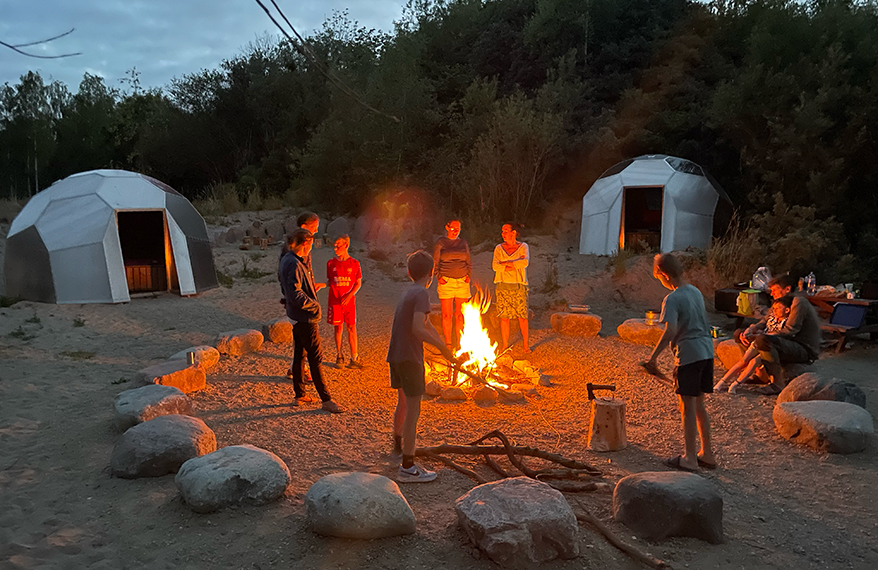 SHELTER VILLAGE, 2023/2024 |
||
Introduction:
The SHELTER VILLAGE is a low-cost, highly durable system that provides basic shelter for persons or groups of persons against rain, sun, cold and wind. it can be placed both in cityscapes and landscapes and can be used by any person that needs a break from the weather conditions, needs to rest or needs a place to sleep. The images shown in this manual are from an actual construction of a permanent SHELTER VILLAGE in Denmark. The system can of course be varied and adapted to different situations.
Background:
In the spring of 2022, N55 and Anne Romme were invited by the Danish Arts Foundation to compete in designing a group of shelters for Tarup-Davinde, a former gravel pit area. We won the competition and developed SHELTER VILLAGE for this purpose.
In recent years, shelters have been established in nature across Denmark by both private individuals and public organisations, providing free access for everyone—hikers, families, and others who wish to sleep outdoors. SHELTER VILLAGE can be seen in this context.
Description of SHELTER VILLAGE in Tarup-Davinde, Denmark:
In the project, N55 has emphasised the importance of contributing constructively and positively to creating a new narrative based on the unique cultural and natural history of the site.
We have not tried to camouflage the shelter site in relation to the landscape, but on the contrary, through the choice of materials and the layout of the site, we have emphasised that there is something man-made and unexpected here. The goal has been to create a well-functioning and exciting place where communities can thrive and where different impressions can provide interesting experiences that you share with others when you get home and the story of the new Tarup-Davinde slowly spreads.
It is crucial to us that SHELTER VILLAGE works optimally in practice, has a long durability and is sustainable both socially and environmentally. The materials used in the project are unusual in shelter contexts, but are highly resistant to daily use, wind and weather.
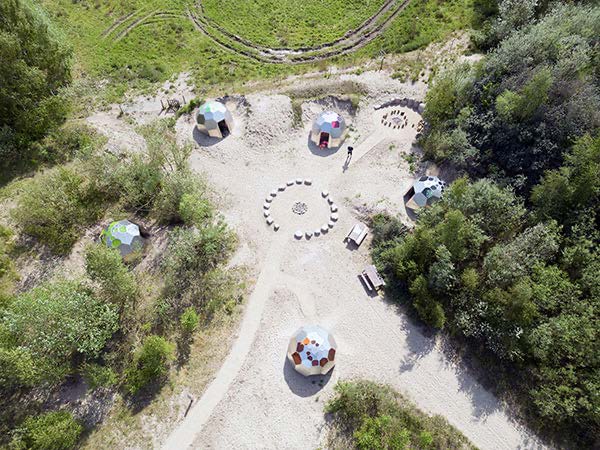
We found inspiration and took the morphology and geometry of the sea urchin as our starting point in terms of form. The fossilised sea urchin is one of Denmark's most common fossils and is familiar to most people, children and the elderly alike. It is easily recognisable and can be found everywhere in the gravel from the gravel pit, along with boulders and stones from all over Scandinavia.
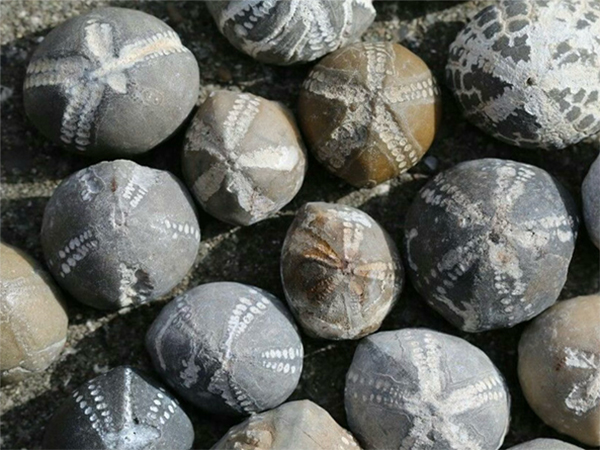
Nature is a master at creating material-optimised and strong constructions. You can see this when you look at the limestone slabs that form the sea urchin's shell. We have utilised this to create a strong and spacious, minimal construction.
We have chosen to create a ‘village’ consisting of five shelters with room for six sleeping adults in each. The five separate units look like large stones shot out of the frost from the moraine. Five functional sculptures that you suddenly encounter in the landscape.
The emphasis has been on providing users with effective protection from rain and wind. At the same time, we have tried to create high-ceilinged spaces with views, not only through the entrance, but also through openable hatches and windows. The windows are coloured and have shapes similar to those found in the world of crystals and thus also in the boulders found in the area.
Each shelter has its own window colour and pattern. You will therefore be able to easily identify the shelter you will be sleeping in. Parts of the interior are covered with complementary coloured wool felt. The strong, thin, protective shell thus appears soft and organic on the inside. During the day, the interior of the shelter will be illuminated in a strong colour such as magenta, yellow, cyan, orange or green. The landscape will therefore take on a different colour when seen from the inside. The same goes for stars, planets and the moon, which you can look up at at night. Or the sunrise in the morning. There will be access from the outside to the firewood stored under the sleeping platform.
At the entrance there is an arch with floor space. The sleeping platform can also function as a seating area where you can sit and chat in the shelter from the rain and wind. Users in each shelter are also well shielded from the surroundings when it comes to changing clothes etc. The height of the sleeping platform is adapted to recommendations for physically challenged people in wheelchairs. The door is also wide and high enough for a wheelchair to pass through.
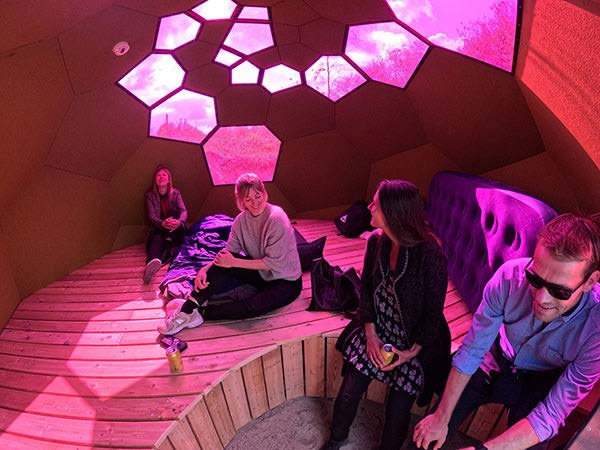
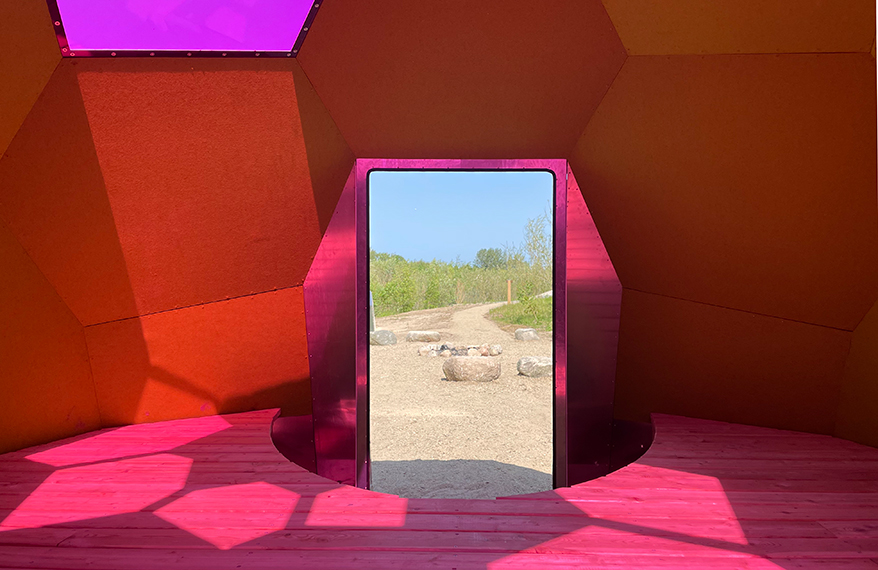
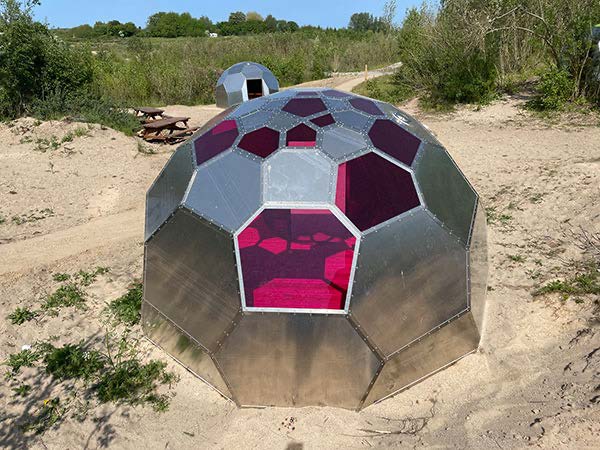
The sea urchin plates always sit in a pattern that is divisible by five when viewed from above. We have used this to position the shelters as large stones in relation to a central point with five axes. In the centre there is a ‘thing place’ consisting of local stones placed in a circle. They will function as seating around a ‘communal kitchen’ in the form of a fire in the centre. We envision barbecue grills being installed here so that many people have the opportunity to cook their various meals over the same fire. To enable different groups to use the space at the same time, we have chosen to place another fire pit integrated into the hill. It's a little out of the way and is built as an ‘amphitheatre’ with a fire in the middle and the opportunity for an excursion leader or a nature guide, for example, to talk about tomorrow's programme. Or it can be used for a performance with music or similar to take place in front of a seated audience. The amphitheatre is constructed with logs, earth textile, topsoil and grass, combined with local stones.
There is free placement of five table/bench units with seating for a total of thirty people in the area, allowing users to create a long table or to distribute the tables to different groups as needed.
In the spring of 2022, N55 and Anne Romme were invited by the Danish Arts Foundation to compete in designing a group of shelters for Tarup-Davinde, a former gravel pit area. We won the competition and developed SHELTER VILLAGE for this purpose.
In recent years, shelters have been established in nature across Denmark by both private individuals and public organisations, providing free access for everyone—hikers, families, and others who wish to sleep outdoors. SHELTER VILLAGE can be seen in this context.
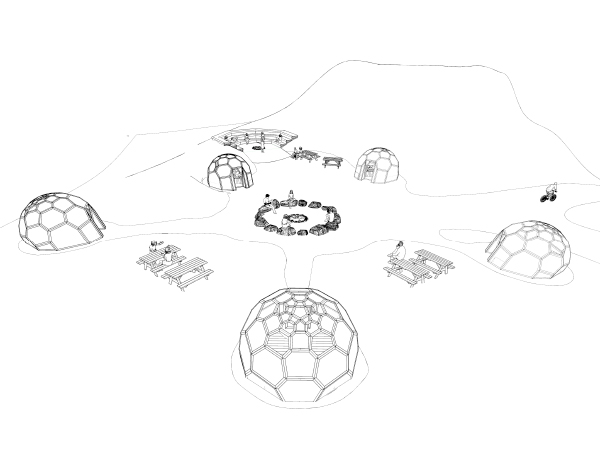
Construction:
The construction of SHELTER VILLAGE is based on the SPACEPLATES building system by N55 in collaboration with Anne Romme and Anne Bagger.
The construction of the shelters is a so-called ‘pure plate’ or spaceplate construction, which differs fundamentally from the more familiar grid construction often used to construct dome shapes. This method is characterised by its ability to minimise material consumption to an extreme degree. This means that large airspaces can be contained at low cost. The main structure consists of laser-cut aluminium plates. The sheets are joined together with ‘angles’ also consisting of laser-cut aluminium, but bent to the correct shapes. Everything is assembled with aluminium blind rivets. The windows are laser-cut acrylic. The shape is perfect for withstanding high wind speeds. Foundation/anchoring is done with ground screws. Once the system is worn out, the screws are simply unscrewed, the shelter is disassembled and can be moved or reused in other ways. To counteract dripping from condensation of exhaled air from users and to handle general humidity, wool felt is fitted on the inside of a number of the panels. The wool is non-flammable and suitable for absorbing large amounts of moisture and then releasing it again when ventilated. The side panels are unclad and will therefore act as condensation surfaces that dissipate condensed moisture. In addition, there will be integrated ventilation in the form of vents in the surface and hatches that can be opened towards the landscape. The interior/ sleeping platform is built from wood. Thanks to the production technology used, we can afford to vary the expression of each shelter without increasing the cost. Fire safety has been taken into account in the technical design for regulatory approval.
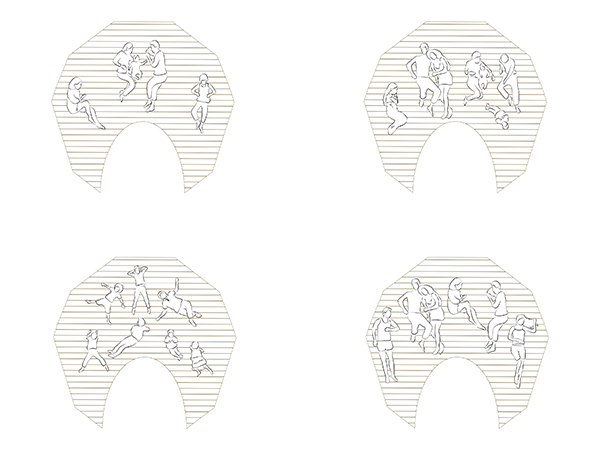
Sustainability:
There are different strategies for building in an environmentally sustainable way, things that can rot are usually considered to be good and sustainable materials. We want to challenge these notions with a more playful and open approach. We have chosen to combine a method of sourcing materials as locally as possible, or recycling, with the intention that the materials have a long lifespan. As an example: Aluminium lasts at least 50 years in practice. It is strong and you can therefore minimise materials. Aluminium is the most common metal on earth and the third most common element. We will never run out of aluminium. But it requires energy to extract it. Therefore, it should preferably be produced with hydropower or similar. On the other hand, it is easy and requires little energy to recycle endlessly.
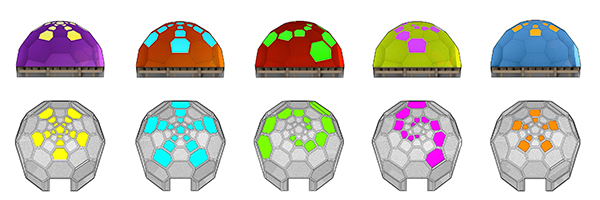
The aluminium sheets are produced using hydropower by a Scandinavian manufacturer. The processing will take place in Denmark. The windows are made from recycled acrylic. Sealing strips are made of natural rubber. The interior is made of wood from local sawmills or can alternatively be made cheaply from recycled scaffolding beams. The wool felt is from local Jutland sheep.
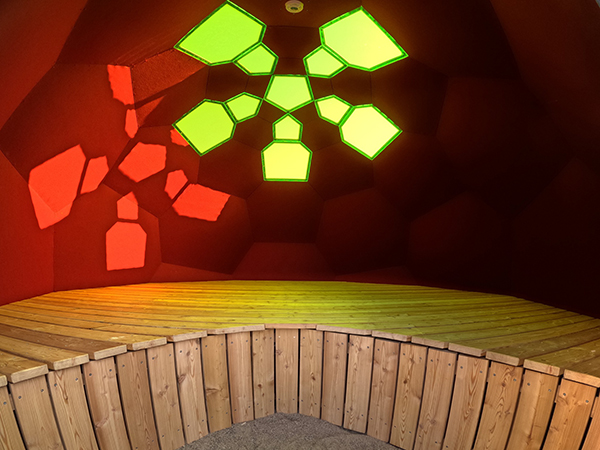
Maintenance:
The shelters are not expected to require maintenance for at least a 20-year period. The exception will be repairs due to vandalism, but replacement parts will be cheap. Of course, normal cleaning and maintenance of the site as such can be expected.
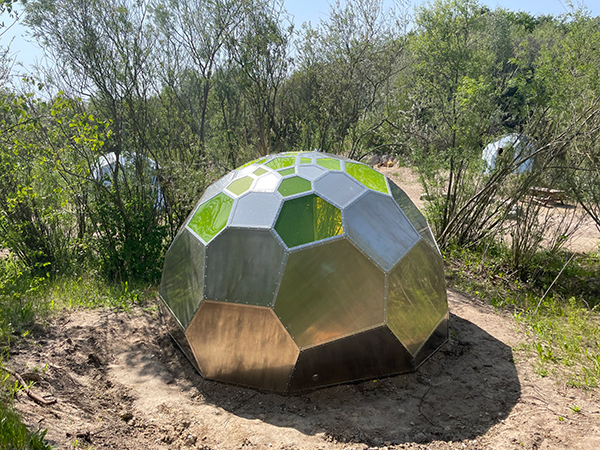
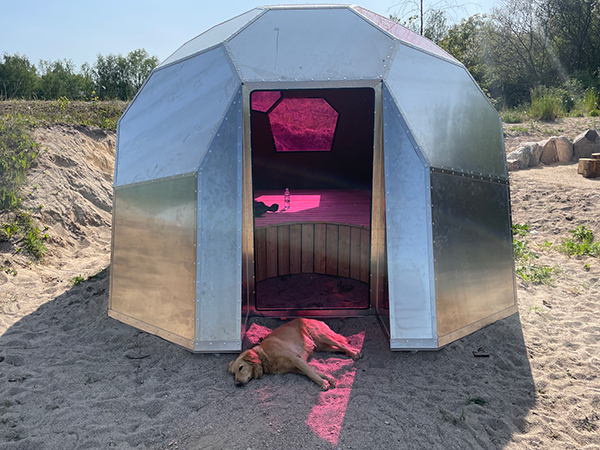
Models from the proposal:
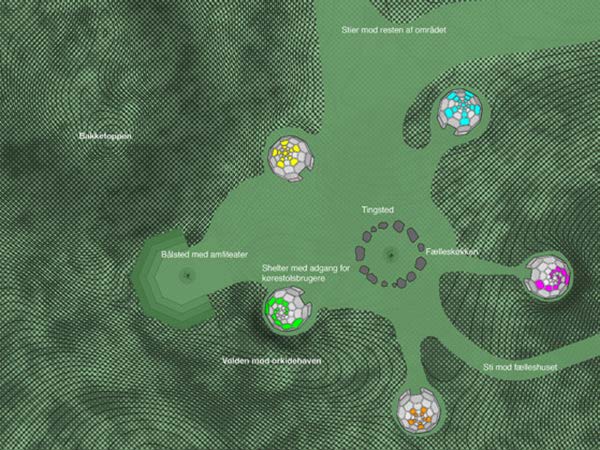
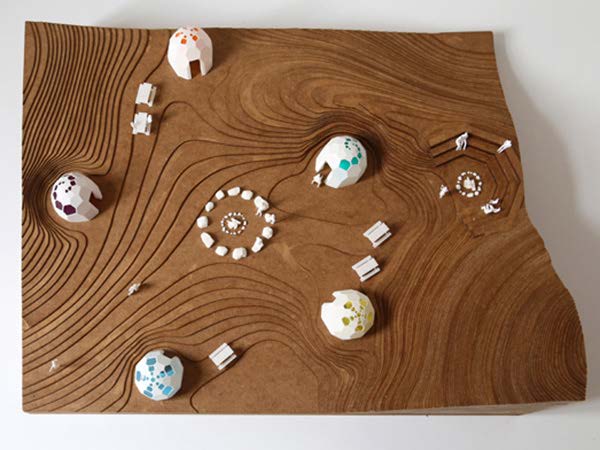
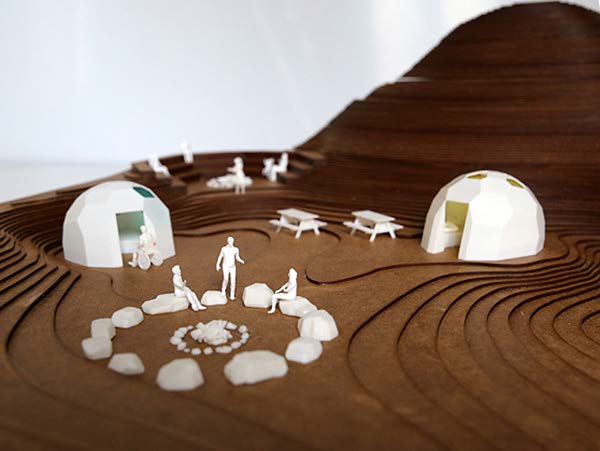
By N55 and Anne Romme in collaboration with Anne Bagger.
Thanks to: Sigfus Brage Sørvin Romme, Till Wolfer, Conor Coughlan, Per Schandorff, @njord.green and David Babba
The Project is funded by @statenskunstfond and Tarup Davinde I/S